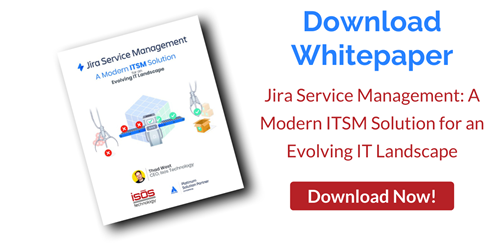 IT Service Management raises your organization’s game across all departments by elevating the service experience for customers, freeing your agents to get busy innovating, and bringing your teams together to collaborate in an agile approach.
IT Service Management raises your organization’s game across all departments by elevating the service experience for customers, freeing your agents to get busy innovating, and bringing your teams together to collaborate in an agile approach.
There are several ITSM platforms available, all with their own benefits depending on your organization’s needs and approach. Isos Technology recommends Atlassian’s Jira Service Management (JSM) for its cost-effectiveness, ease of use and robust features.
TechTarget reported that IT pros are being increasingly swayed to Jira Service Management, citing cost savings over larger vendors’ products, ease of use, and service management flexibility as the reasons for adopting or migrating. Atlassian was the only vendor to earn the “Visionary,” designation in the 2021 Gartner Magic Quadrant, and JSM outranked ServiceNow and other competitors in strategic vision according to Forrester Research’s ITSM Wave reports.
Now that you know JSM's credentials, here are 5 ways that Jira Service Management can improve your business:
1. Up to 75 times more cost-effective than legacy systems
Legacy tools can become budget busters due to maintenance and upgrade costs, but that's not the case with JSM. Atlassian automates servers, storage, and maintenance for you, eliminating their associated costs. Additionally, organizations get immediate access to new features and automatic upgrades. JSM grows with you, providing elastic scaling as needed through AWS cloud hosting, which is why it's used in small, medium, and Enterprise businesses.
JSM’s simple upfront pricing model eliminates difficult negotiations and months-long renewals. To do this, Atlassian offers a free plan for three agents, a standard plan that costs $20 per agent, per month, and a premium plan at $45 per agent, per month.
A Forrester Consulting report found that organizations that deployed Jira Service Management experienced benefits of more than $4 million over three years, achieving a return on investment (ROI) of 246%. Included in those benefits were a 61% increase in service agent productivity and more than $800,000 in savings from retiring legacy ITSM tools.
2. Fast Launch and Easy Implementation
JSM only takes about six weeks to launch and go live for all your organization’s teams, according to the G2Crowd IT Service Management (ITSM) Tools Implementation Index.
Let's compare JSM to another ITSM platform, called ServiceNow, which takes at least five months to go live, and can take up to a year to fully implement, depending on your organization’s size and your infrastructure’s complexity. JSM’s simple interface, on the other hand, includes no code and ready-to-use templates so that your team can hit the ground running right after launch. The G2Crowd Index gave JSM an implementation score of 83%, compared to ServiceNow’s 72% score. The average implementation score across all tools in the index was 75%.
3. One Agile DevOps Platforms for All Your Teams
According to Gartner, “through 2023, 80% of ITSM teams that have not adopted an agile approach will find their ITSM practices are ignored or bypassed as a result of more agile ways of work being adopted elsewhere in the organization.”
Enter JSM as a harmonious, single platform for each of your department teams, including ITSM, DevOps, Customer Support, and Human Resources. Practices inspired by Agile and DevOps are built out-of-the-box, including request, incident, problem, change, and configuration management.
Because JSM is based on Jira Software, the number one tool for agile teams that many organizations already use for software development tickets, it’s also the easiest way to achieve true DevOps collaboration between IT and development teams.
JSM’s core features include patch management, remote access control and maintenance scheduling. It allows for onboarding, off-boarding and change requests for staff, and includes templates for facility, legal, and customer management used to initiate tickets. Other ITSM solutions require third-party system integrations to facilitate many of these features, and don’t have built-in templates for non-IT departments.
Finally, JSM easily integrates with Atlassian’s Confluence for an integrated Knowledge Base. If you opt for JSM Cloud, Atlassian’s alerting and incident response tool, Opsgenie and Insight Asset Management are included in your license.
4. Simplified Customer Portal
JSM allows you to implement a simple and intuitive ticketing portal where customers can get straight to what they care about most, which is the progress of their service requests.
Meanwhile, your customer service agents can efficiently process tickets and resolve issues quickly and satisfactorily. Templated problem management workflows allow your team to provide updates and contextual information to tickets, while customizable visibility ensures only appropriate parties can view that information.
Easy integration with Confluence also lets you provide helpful FAQs and documents to customers and your service team to facilitate faster resolution and better overall request management.
5. 99 Percent Uptime SLA and Enterprise Capabilities
JSM’s Premium and Enterprise licenses both offer uptime service-level agreements of 99.5 percent. They also offer:
- Unlimited storage
- 24/7 support
- Global and multi-project automation
- Asset and service configuration management
- Sandboxing
- Advanced incident and problem management
- Service and infrastructure health analysis
- Deployment gating for CI/CD tools
We've provided of few of the reasons that we think JSM can help businesses and organizations of all kinds, but there are many more than we could list here. If you're interested in learning more about JSM and how we can help implement it effectively at your organization, contact us!
Sign up to receive more great content
Learn more about Atlassian and how Isos can help by signing up to receive our latest blogs, eBooks, whitepapers and more.














